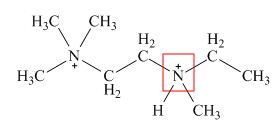
Concept explainers
(a)
Interpretation: The stereogenic centers in the given compound are to be labeled.
Concept introduction: An atom containing four different atoms or groups produces stereoisomers on exchange of any two groups. These centers are known as stereogenic centers.
Answer to Problem 25.1P
The stereogenic centers in the given compound are shown in Figure 1.
Explanation of Solution
The stereogenic centers in the given compound are shown below.

Figure 1
The highlighted nitrogen atom possesses four different groups. Hence, this is a stereogenic center.
The stereogenic centers in the given compound are shown in Figure 1.
(b)
Interpretation: The stereogenic centers in the given compound are to be labeled.
Concept introduction: An atom containing four different atoms or groups produces stereoisomers on exchange of any two groups. These centers are known as stereogenic centers.
Answer to Problem 25.1P
The stereogenic centers in the given compound are shown in Figure 2.
Explanation of Solution
The stereogenic centers in the given compound are shown below.

Figure 2
In the given compound, the nitrogen atom does not act as stereogenic center although it is attached to three different groups and lone pair because of the flipping of
The stereogenic centers in the given compound are shown in Figure 2.
Want to see more full solutions like this?
Chapter 25 Solutions
ORGANIC CHEMISTRY-W/ACCESS
- Locating Stereogenic Centers Locate the stereogenic centers in each drug. Albuterol is a bronchodilator— that is, it widens airways—so it is used to treat asthma. Chloramphenicol is an antibiotic used extensively in developing countries because of its low cost.arrow_forwardSaquinavir (trade name Invirase) is a protease inhibitor, used to treat HIV (human immunodeficiency virus). a.Locate all stereogenic centers in saquinavir, and label each stereogenic center as R or S. b.Draw the enantiomer of saquinavir. c.Draw a diastereomer of saquinavir. d.Draw a constitutional isomer that contains at least one different functional group.arrow_forwardDraw all stereoisomers formed in each reaction.arrow_forward
 ChemistryChemistryISBN:9781305957404Author:Steven S. Zumdahl, Susan A. Zumdahl, Donald J. DeCostePublisher:Cengage Learning
ChemistryChemistryISBN:9781305957404Author:Steven S. Zumdahl, Susan A. Zumdahl, Donald J. DeCostePublisher:Cengage Learning ChemistryChemistryISBN:9781259911156Author:Raymond Chang Dr., Jason Overby ProfessorPublisher:McGraw-Hill Education
ChemistryChemistryISBN:9781259911156Author:Raymond Chang Dr., Jason Overby ProfessorPublisher:McGraw-Hill Education Principles of Instrumental AnalysisChemistryISBN:9781305577213Author:Douglas A. Skoog, F. James Holler, Stanley R. CrouchPublisher:Cengage Learning
Principles of Instrumental AnalysisChemistryISBN:9781305577213Author:Douglas A. Skoog, F. James Holler, Stanley R. CrouchPublisher:Cengage Learning Organic ChemistryChemistryISBN:9780078021558Author:Janice Gorzynski Smith Dr.Publisher:McGraw-Hill Education
Organic ChemistryChemistryISBN:9780078021558Author:Janice Gorzynski Smith Dr.Publisher:McGraw-Hill Education Chemistry: Principles and ReactionsChemistryISBN:9781305079373Author:William L. Masterton, Cecile N. HurleyPublisher:Cengage Learning
Chemistry: Principles and ReactionsChemistryISBN:9781305079373Author:William L. Masterton, Cecile N. HurleyPublisher:Cengage Learning Elementary Principles of Chemical Processes, Bind...ChemistryISBN:9781118431221Author:Richard M. Felder, Ronald W. Rousseau, Lisa G. BullardPublisher:WILEY
Elementary Principles of Chemical Processes, Bind...ChemistryISBN:9781118431221Author:Richard M. Felder, Ronald W. Rousseau, Lisa G. BullardPublisher:WILEY





